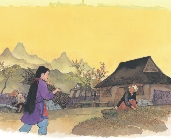Language and Grammar, continued
1 TRY OUT LANGUAGE
2 LEARN GRAMMAR
3 APPLY ON YOUR OWN
Use Nouns
A noun names a person, place, thing, or idea.
• A singular noun names one person, place, thing, or idea.
EXAMPLE The farmer carries a bucket. • A plural noun names more than one person, place, thing, or idea.
EXAMPLE All the farmers carry buckets.
1. To make most nouns plural, just add -s.
EXAMPLE vegetable + -s = vegetables They grow many vegetables. 2. If the noun ends in s, z, sh, ch, or x, add -es.
EXAMPLE lunch + -es = lunches He prepares all the lunches. 3. If the noun ends in y after the consonant, change the y to i and add -es.
EXAMPLE 
Spelling Rules
Practice Together
Change the noun in the box to the plural form. Say it. Then say the sentence and add the plural form of the noun.
| 1. house | There are many _____ in the village. |
| 2. box | They look like small _____. |
| 3. field | Almost everyone works in the _____. |
| 4. baby | The grandparents take care of the _____. |

The villagers work outside.
Try It!
Change the noun in the box to the plural form. Write the plural form on a card. Then say the sentence and add the plural form.
| 5. stream | Two _____ flow by the village. |
| 6. bush | Some _____ grow near the water. |
| 7. basket | Kids bring their _____ every morning. |
| 8. berry | They pick the ripe _____. |